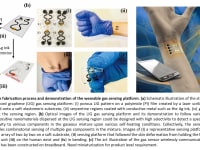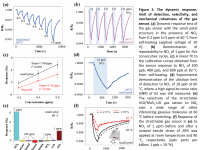
The recent development of wearable electronics has drawn considerable attention from both academia and industry. Because wearable electronic devices can conform to and follow the deformation of the skin, they are capable of capturing various essential mechanical, thermal, chemical, electrical, and biological signals, demonstrating an excellent potential for future healthcare monitoring applications. Though continuous recording and analysis of gaseous compounds bear significant importance in healthcare, the study of wearable gas sensors for toxic gas detection, environmental air quality monitoring, breath analysis, and providing warning signs to individuals in a hazardous gas environment has only commenced recently. As one representative example, nitrogen dioxide (NO2) is one of the most prominent toxic air pollutants from the combustion of fossil fuel. Inhaling at low concentration can cause symptoms such as asthma, bronchitis, and emphysema. Long-term exposure can lead to heart failure and dysrhythmia. Therefore, there is an increasing demand for the development of wearable gas sensors to provide accurate and continuous recording of NO2. Wearable gas sensors can also enable the direct monitoring of the odors released from the human body to help inform the health conditions.
Compared to their industrial counterparts, the development of wearable gas sensors needs to address additional challenging requirements, including lightweight and small form factor, low operating temperature, low energy consumption, and mechanical robustness upon various skin deformations. Nanomaterials are promising candidates for gas sensing application due to its significantly increased surface-to-volume ratio. However, nanomaterials-based gas sensor normally require the use of interdigitated electrode and a heating element to lower the sensor's resistance to a readable level and facilitate the sensing rate, respectively. However, the use of IDEs and separate heaters increases fabrication complexity.
Here, a novel wearable gas sensing platform based on laser-induced graphene (LIG) with surface modification with self-heating function is fabricated. Dispersing various highly sensitive and selective nanomaterials in the self-heating region of LIG results in a gas sensor array to identify various gaseous components in the mixture. Systematic investigations of the LIG heater geometric parameters (i.e., linewidth ranged from 120 μm to 240 μm), operating temperature (20ºC-80ºC) from self-heating, and various nanomaterials (MoS2, ZnO, CuO) demonstrate their effects on the gas sensing performance. Taken together with the stretchable design layout to provide mechanical robustness over a tensile strain of 20%, the gas sensor with a significant response, fast response/recovery processes, excellent selectivity, and an ultralow limit of detection (1.5 parts per billion ) at a modest temperature from self-heating opens up new opportunities in epidermal electronic devices.Such wearable gas sensors can be deployed to human subjects to serve as part of the internet of things (IOT), that can have real-time monitoring of the air quality of either heavy traffic streets or industry production sites.
-
Awards
-
 2020 Top 100 Entries
2020 Top 100 Entries
Like this entry?
-
About the Entrant
- Name:Ning Yi
- Type of entry:individual
- Patent status:pending








